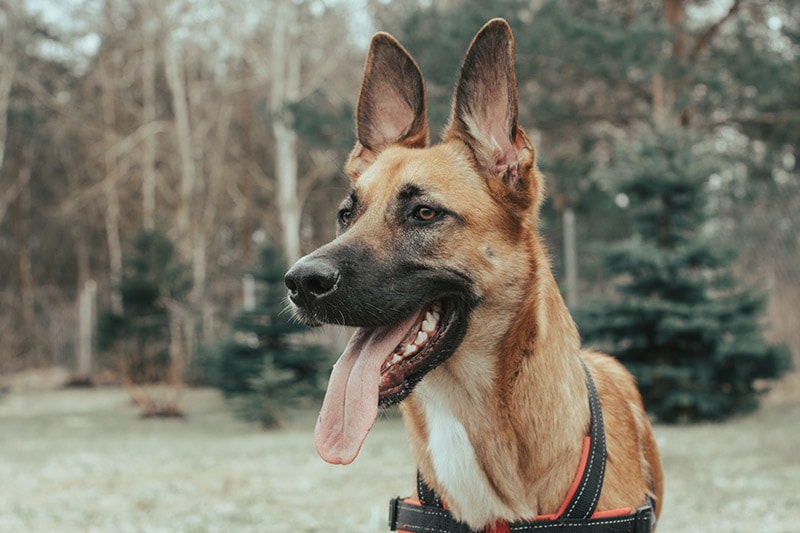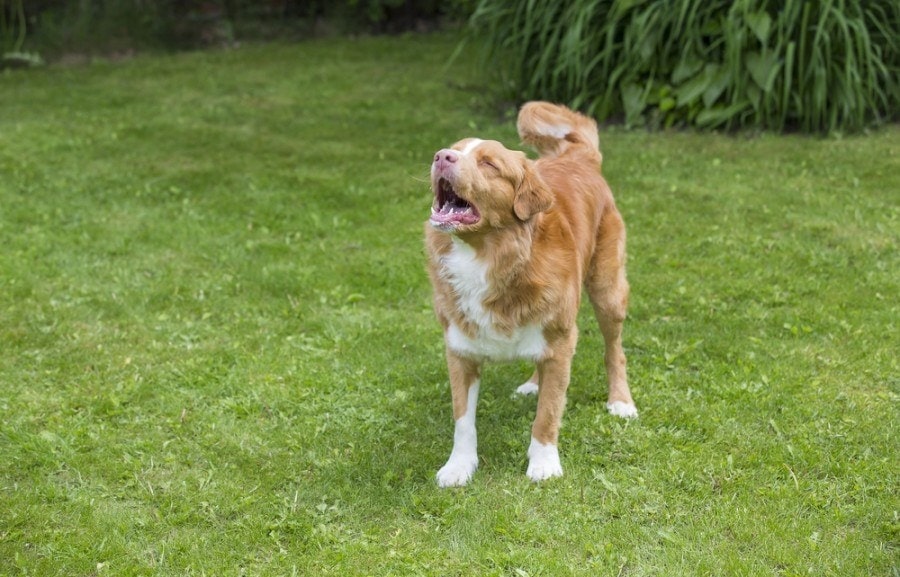Dog Ear Language: 6 Positions and What They Mean

Updated on

Click to Skip Ahead
Dogs can express what they’re feeling in many ways, including through the position of their ears. Combining this with their body language, the look in their eyes, and even the movement of their tail, a dog can tell you a great deal about themselves. When you know what to look for, understanding their language is easy.
To communicate with your dog, you’ll need to familiarize yourself with the myriad ways that they can hold their ears. Once you recognize each position, use this guide to determine what your dog is trying to tell you.
The 6 Dog Ear Positions and What They Mean
1. Relaxed

Most of the time, your dog will be relaxed, so their ears will be too. This is the easiest ear language to read because it’s the one that you’re likely to see the most often—until something captures your dog’s attention, like the sound of a can opening.
Relaxed dogs will hold their ears in a natural position. Dogs with pointed, upright ears will hold their ears up straight but without the alert, forward tilt that they demonstrate when something catches their attention. Floppy-eared dogs can be harder to read. Their ears will be relaxed and hang slightly forward.
2. Pointed Forward or Perked Up

It’s quite obvious when dogs are focused on something. Whether they have floppy or pointed ears, they’ll always lift and tilt them forward when something has caught their attention. Most often, your dog’s ears will go from completely relaxed to upright and tilted when a noise or something else gets their attention.
You’ll also need to pay attention to their body language here to determine whether they’re simply curious about something or about to chase after a squirrel or lunge at an approaching dog.
Relaxed but alert dogs will tilt their ears toward whatever has caught their attention and look at it. Their body language will be completely relaxed but attentive, and you might see them tilt their head too. If they’re aggressive, their posture will be more rigid, and they might shift their stance so they’re lower to the ground, ready to stalk their target.
3. Slightly Back and Relaxed

Another relaxed ear position is when the ears are held slightly back but not pinned flat against the skull. It might be difficult for you to differentiate between a relaxed tilt back and pinned, since they’re similar positions. Both have different meanings, though, and you can tell the difference by how tense your dog is and their posture when they tilt their ears back.
Your dog will hold their ears slightly back when they’re feeling calm or friendly, meeting new people, looking for attention, and seeking food.
4. Extremely Pinned Back or Flattened

Unlike the friendliness that your dog shows when they hold their ears slightly back, when they pin their ears or flatten them, they’ll be visibly distressed. This ear position occurs when your dog is scared, anxious, stressed, or nervous.
They’ll also adopt a hunched position to make themselves smaller and often tuck their tail between their legs. Dogs will do this to show that they’re not a threat and will try to further alleviate tension by sneezing, yawning, or licking their lips.
5. One Ear Dropped or Folded

Not all ear positions are an intentional way of communicating. Sometimes, it’s the result of an ear infection or another health issue. If you notice your dog holding one ear in a neutral, relaxed position, but the other is folded, droopy, or otherwise held in an odd position, your dog might be suffering from a problem with that ear.
This ear position is often accompanied by a tilted head, excessive head shaking, or frequent pawing and scratching at the affected ear. If your dog is suffering from an ear infection, you’ll also see other signs, such as loss of balance, a strong odor from the ear, or oozing.
6. Moving Ears

The most amusing ear position that dogs can demonstrate is when they can’t seem to decide what they want to do with them. Their ears will perk up, twitch, rotate, and even move individually. Your dog will do this because they’re confused, listening to sounds around them, or concerned about something.
If you’re in a busy room, your dog’s constantly moving ears are their way of monitoring everything that’s going on. They might also be concerned about the number of people around them, especially if they’re not used to busy situations. You’ll need to pay attention to the situation that you and your dog are in and their body language to determine why their ears are moving so much.
How Do You Know What Your Dog’s Ears Are Telling You?
When it comes to determining what your dog is trying to tell you, the position of their ears should be considered along with their body language and your familiarity with the dog.
Your dog can change their ear position whether they have floppy or pointed ears; it just takes more attention from you to see the different positions with floppy-eared dogs. Pay close attention to the base of your dog’s ears, and you’ll find that they’re just as expressive as any pointy-eared canine’s.
Body Language
Your dog won’t just use their ears to communicate with you; their body language will speak for them too. To accurately understand what your dog is trying to tell you, pay attention to every inch of their body, from the tip of their nose to their tail. Paying attention to your surroundings when your dog is speaking with their ears is also essential.
Some dogs will tilt their ears forward if they’re alert and curious about something or if they’re feeling aggressive. You can tell the difference by looking at their body language. If their ears are perked forward and their body is relaxed, they might just be paying attention to something in front of them.
Aggressive dogs will demonstrate the same alertness with their perked ears but combine it with a tense body, raised hackles, or a “stalking” position. These cues, along with their ear position, can help you determine what your dog is trying to say.
Familiarity
When you first start paying attention to your dog’s ears, it can be a challenge to remember everything. As you get to know your dog, though, you’ll find that you won’t need to double-check what the position of their ears means. You’ll see their alert gaze and stalking position on a walk and automatically think, “Oh, they’ve seen a squirrel,” or you’ll spot their flattened ears and hunched posture and wonder what scared them.
Learning how your dog talks is a result of getting to know them as an individual and recognizing what their body language is telling you.

Do Ear Positions Always Mean Something?
The position of your dog’s ears can tell you a great deal about what your dog is feeling, and there’s always a reason that they move. It can be as simple as your dog listening to something that you can’t hear, but they may also be trying to get your attention so they can get extra love. Or, they might have an ear infection that needs treating. Paying attention to the cues that your dog gives you is a crucial part of understanding them better.
Conclusion
You might think that the movement of your dog’s ears is simply a cute quirk, but dogs express themselves through the position of their ears. Reading their ears can tell you when your dog is feeling stressed, fearful, alert, relaxed, confused, or aggressive. Their ear position can even tell you if they have a health issue.
Recognizing the different positions of a dog’s ears and knowing what they mean will help you understand what your dog is communicating to you.
Related read:
- Living With a Dog with Dementia: Vet-Reviewed Care Guide & FAQ
- 8 Types of Dog Growls and Their Meanings (with Audio)
Featured Image Credit: Marzena Ko, Unsplash














